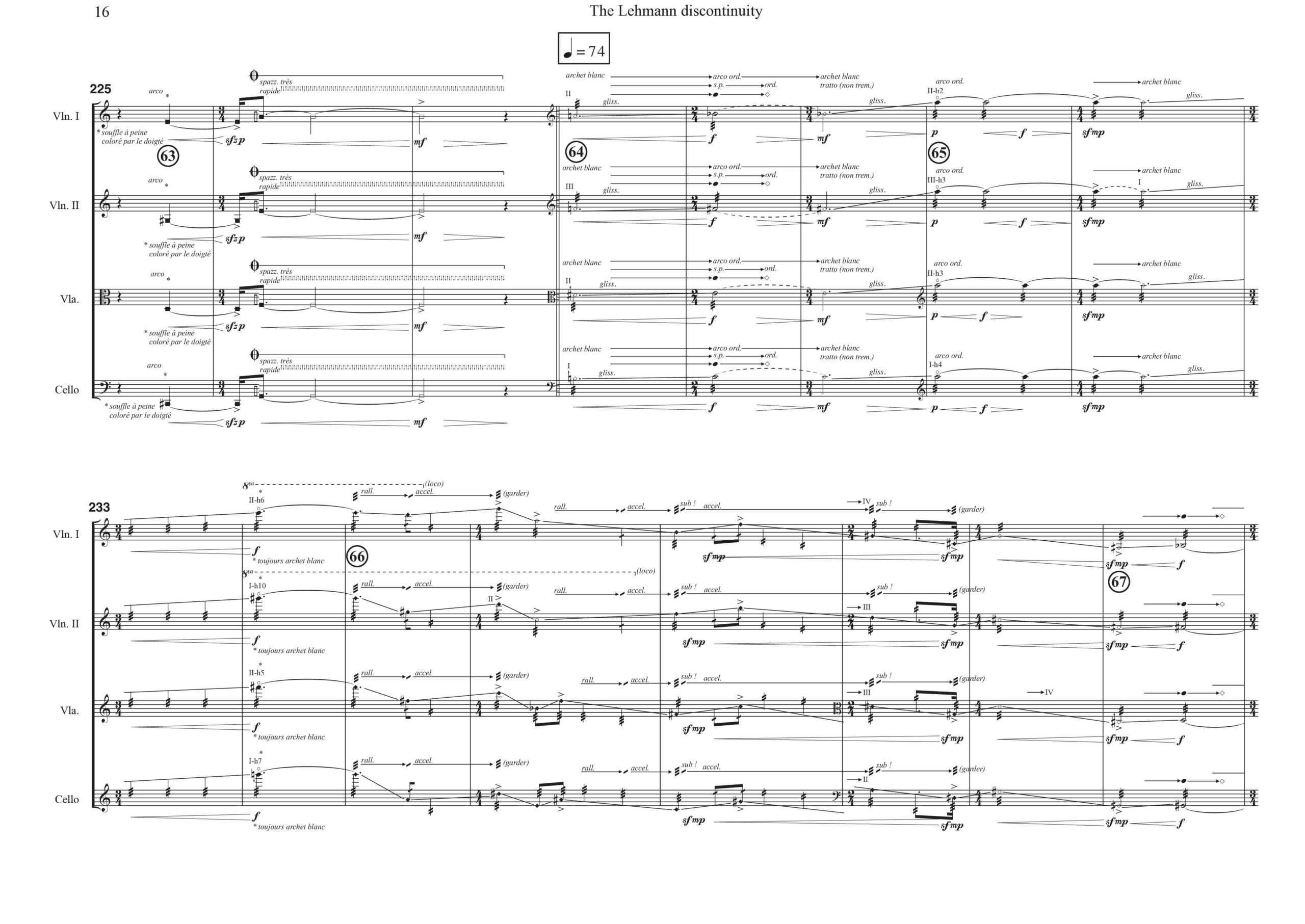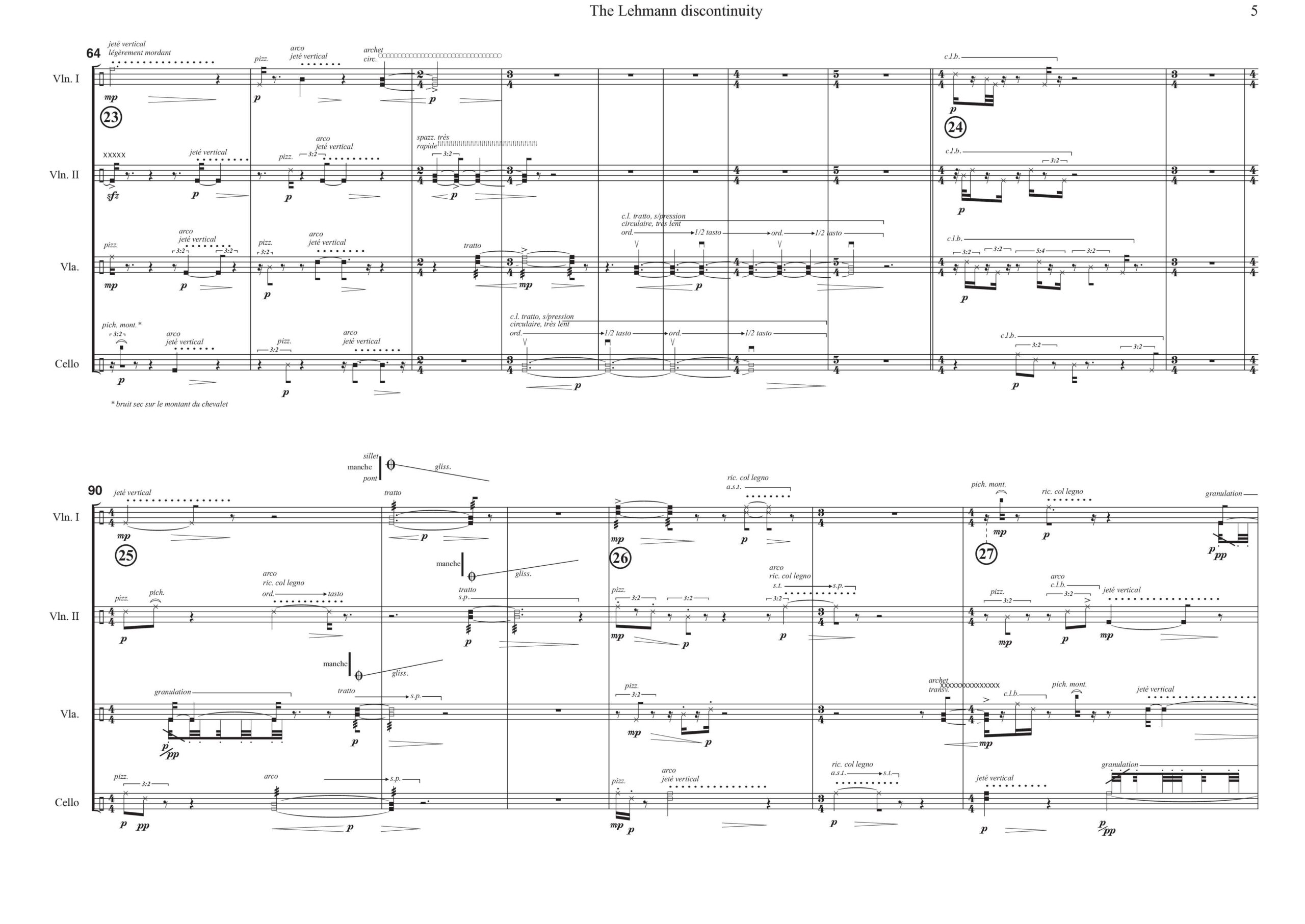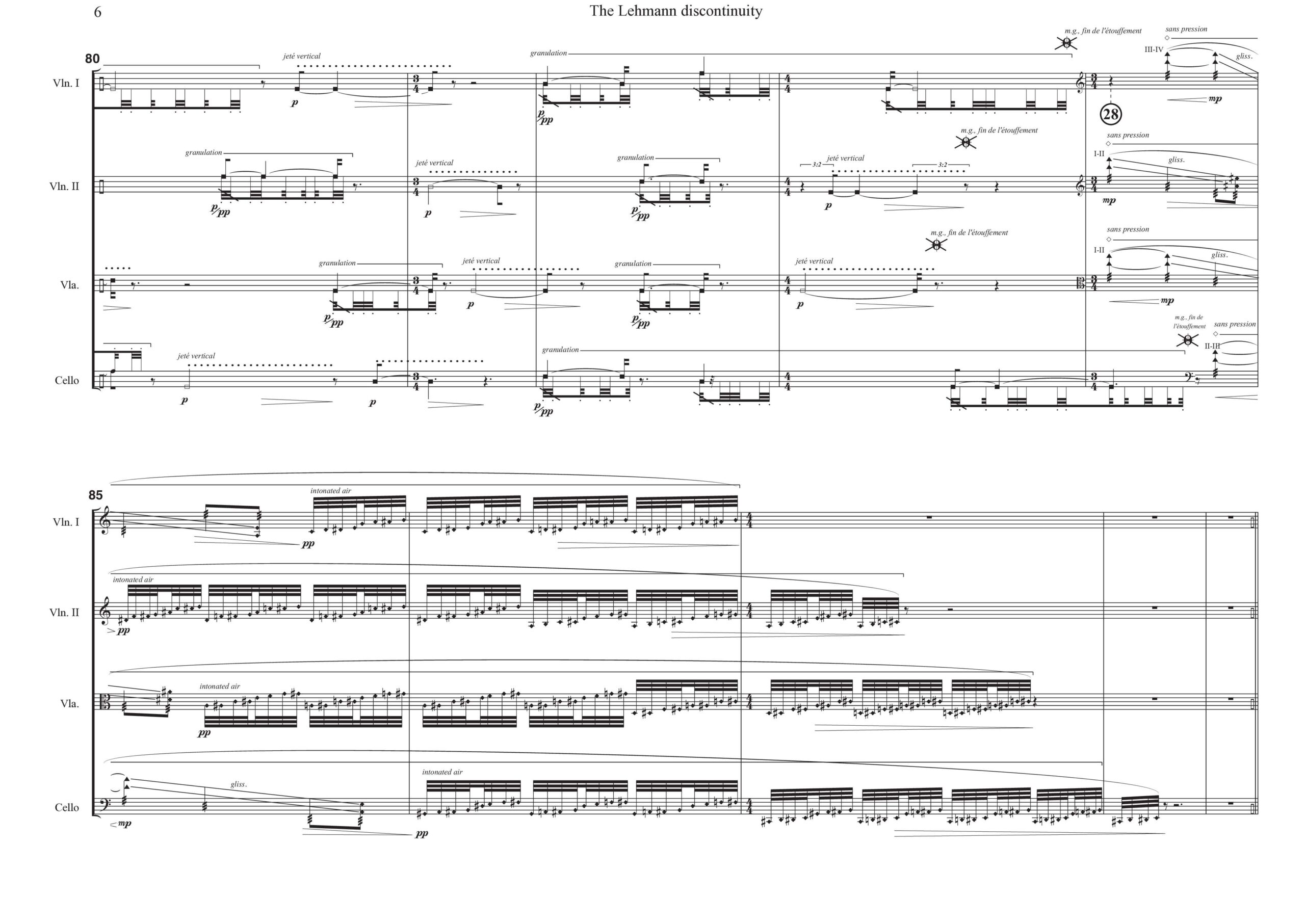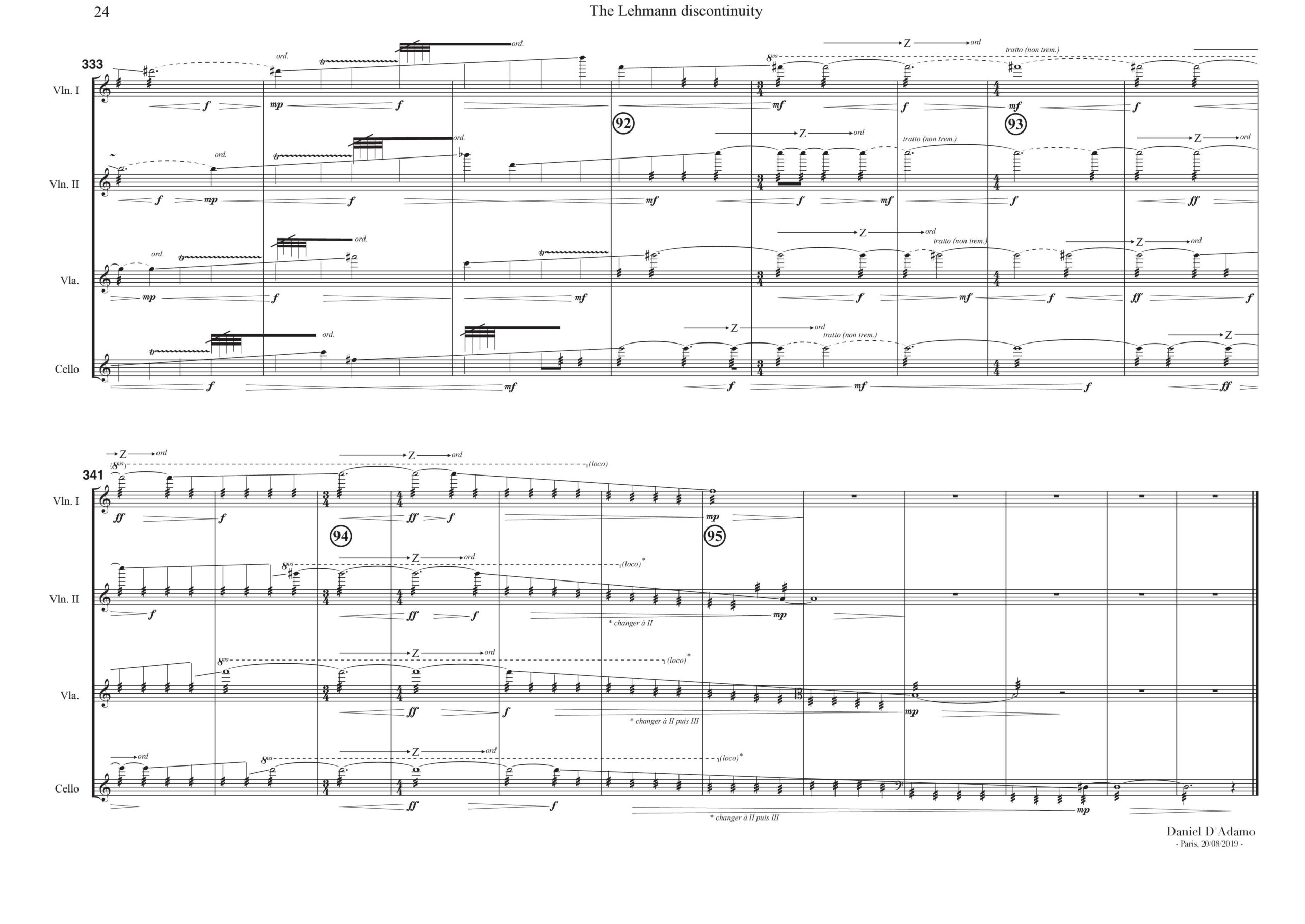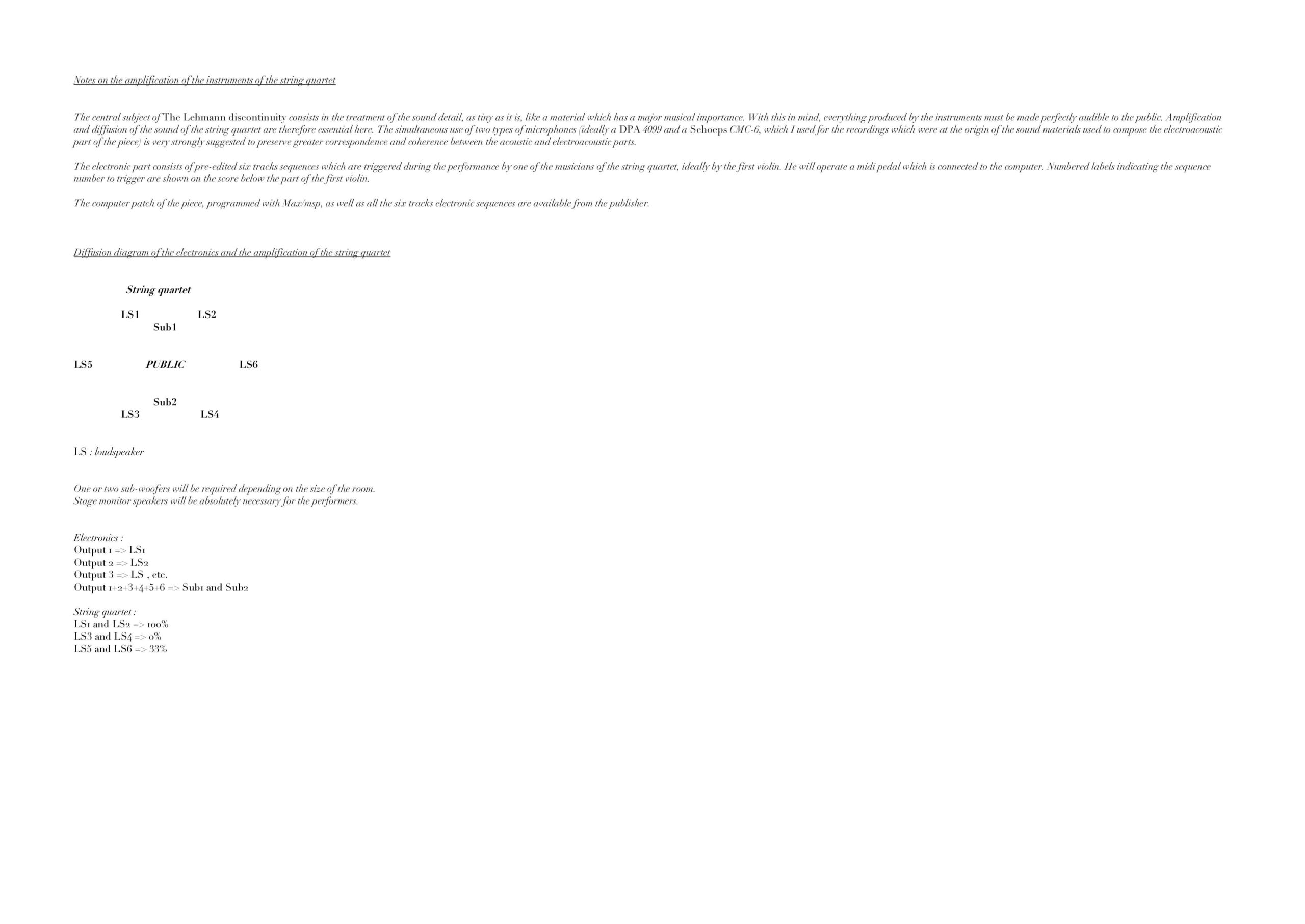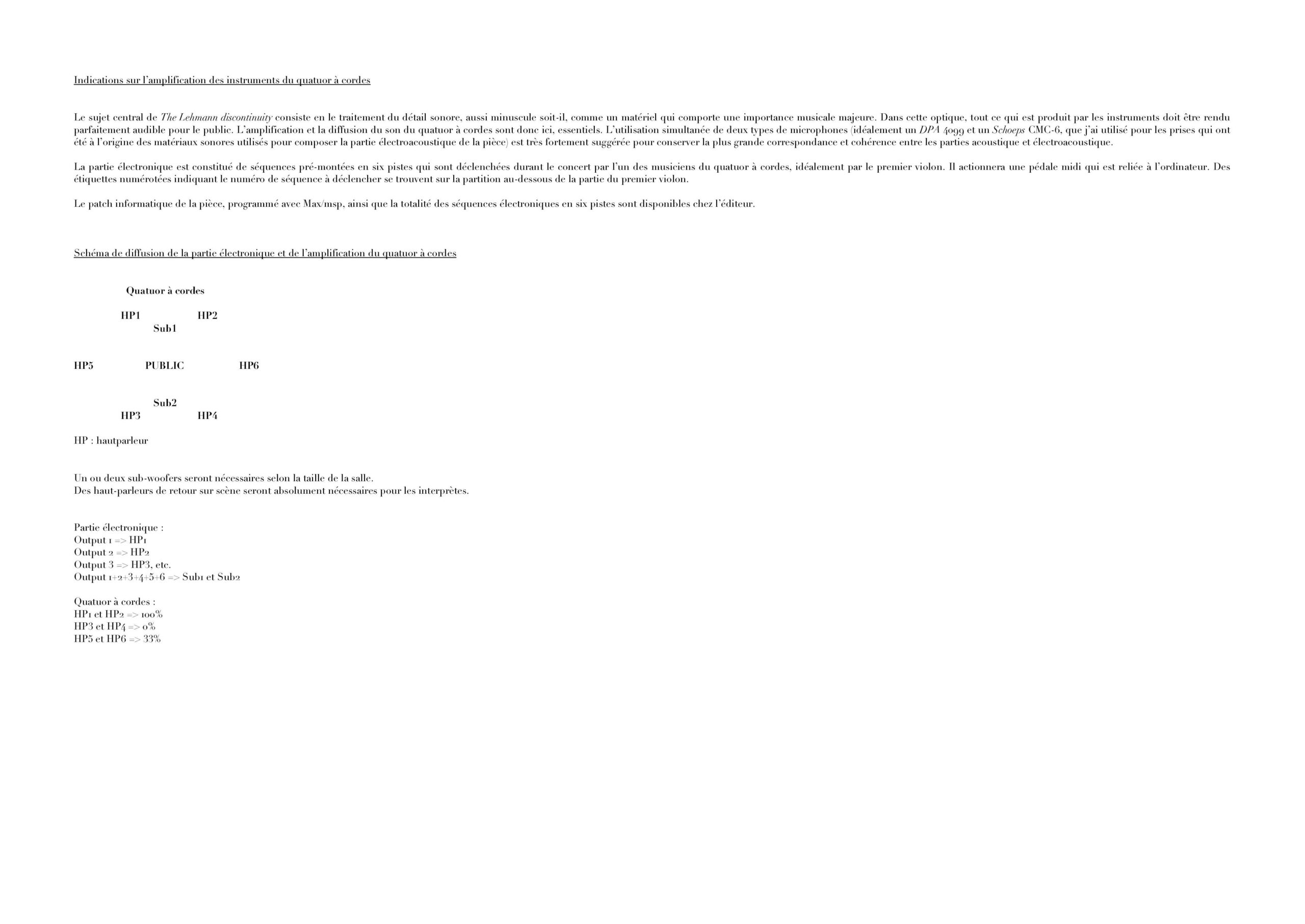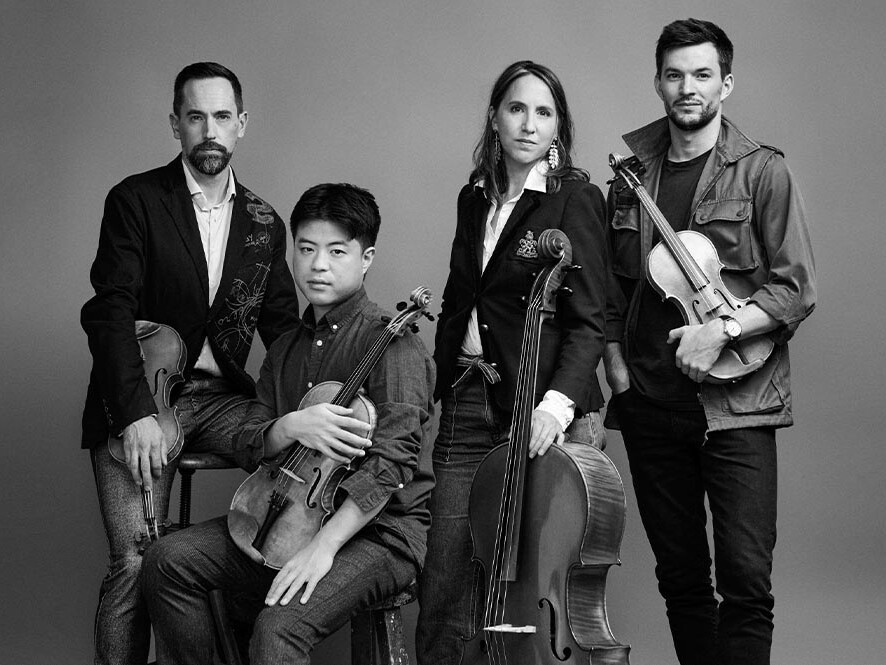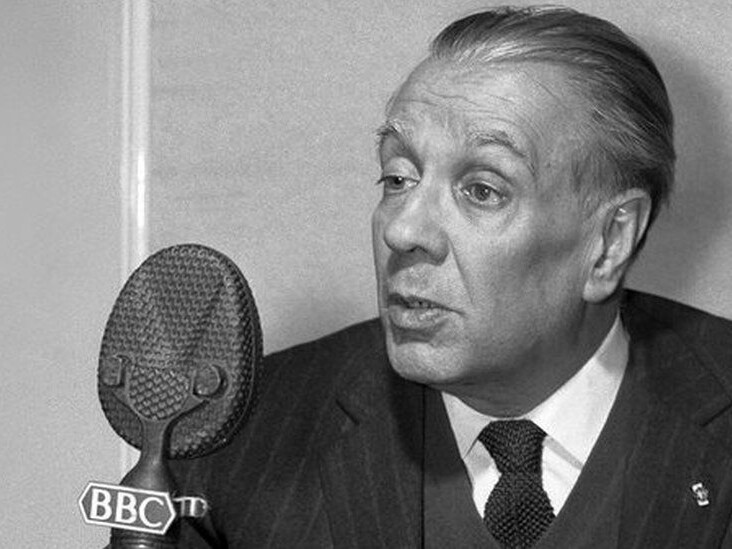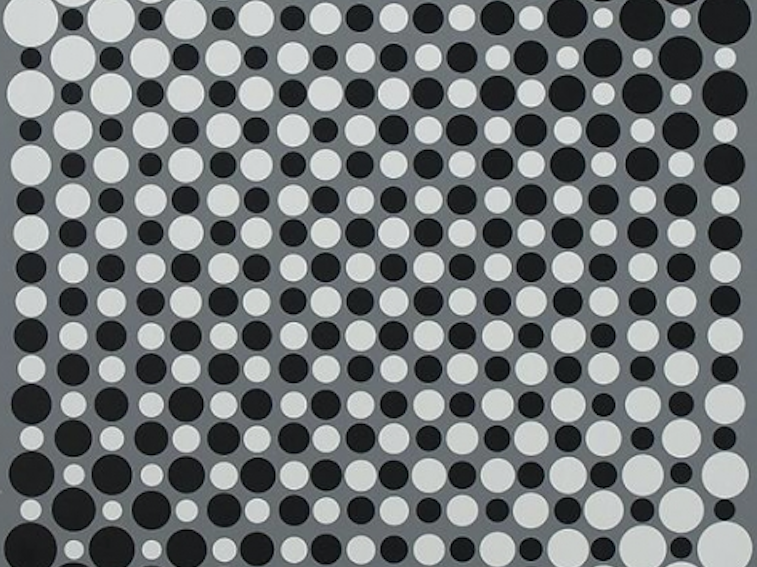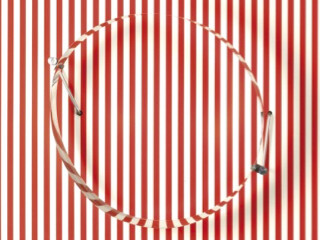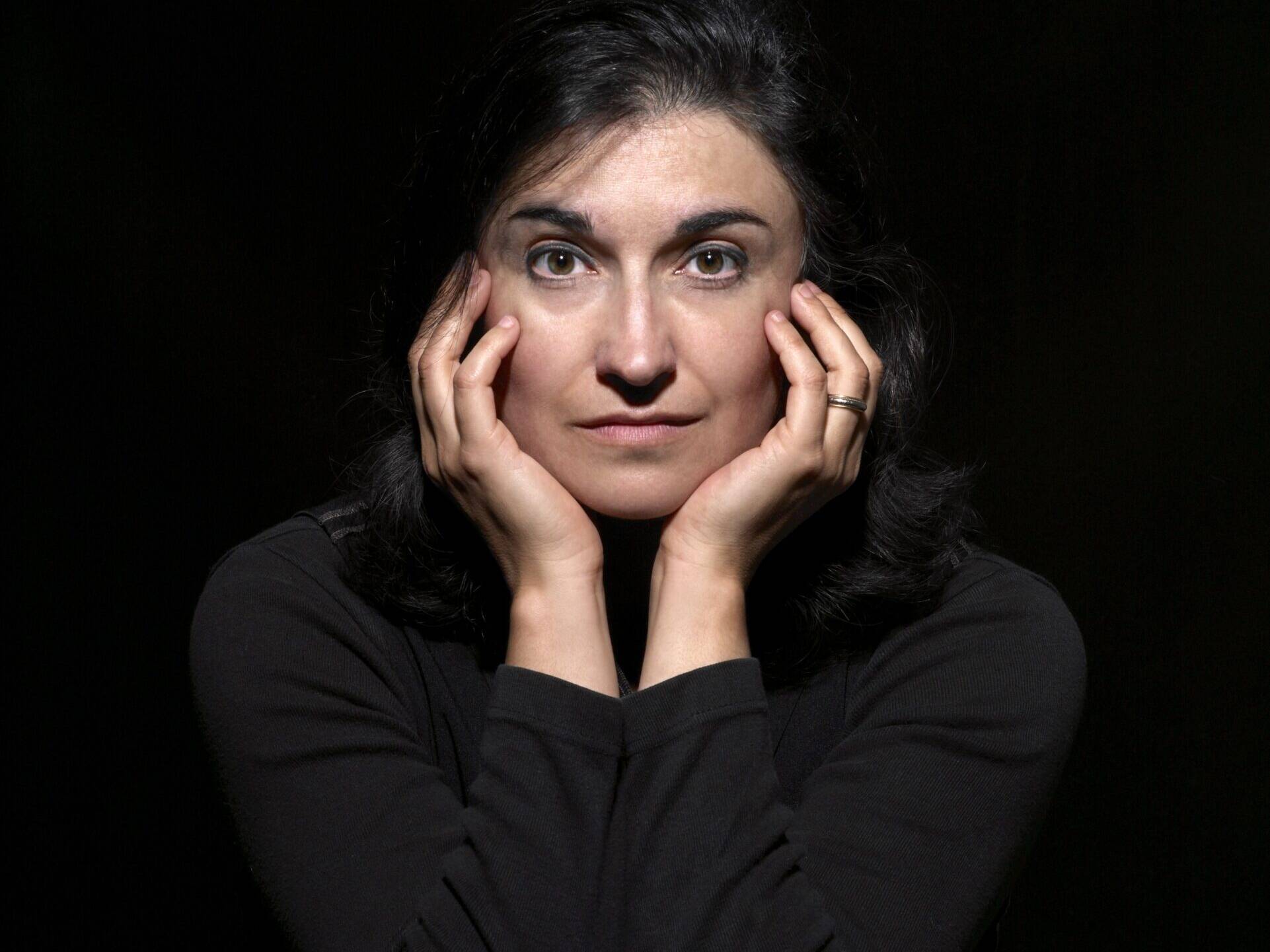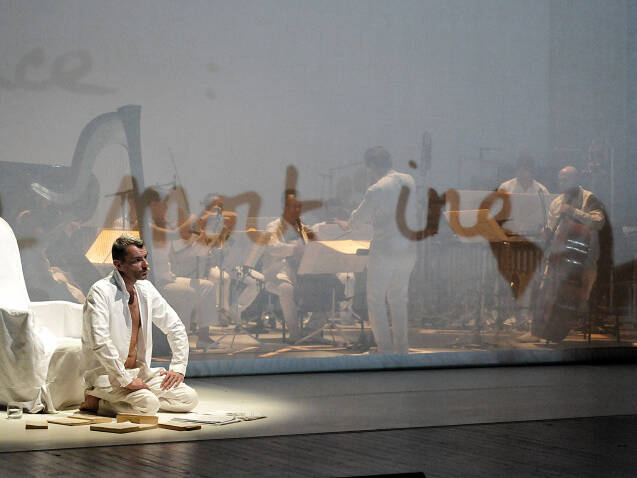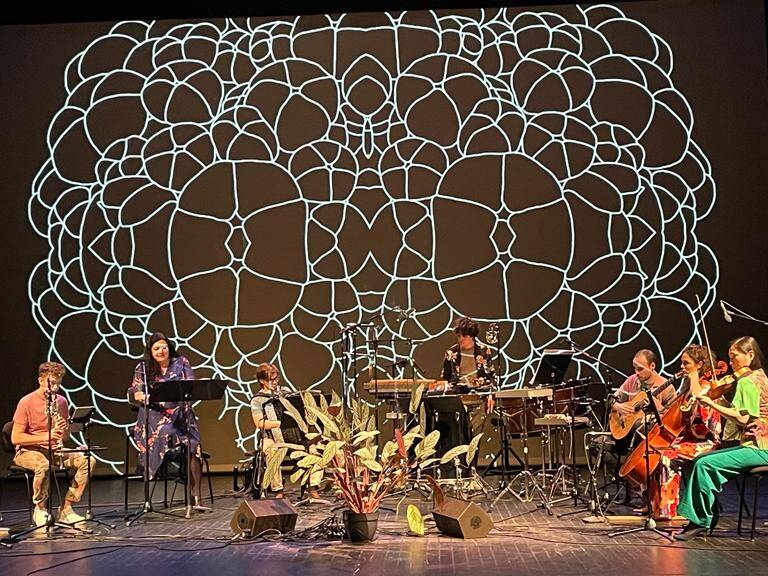The Lehmann discontinuity
Publisher:
Première:
2020, Tana quartet, Ircam-Festival Manifeste, Centre Georges Pompidou - Grande salle, Paris, France.
Year
2019
Commission:
Ircam and Tana quartet
Duration:
20 min
The Lehmann discontinuity – 2019
for string quartet with electronics
to the Tana quartet
The starting point for the composition of The Lehmann discontinuity *, for string quartet with electronics, was the musical observation of sound materials that were both tiny and extremely detailed, expressing a strong musical potential. Nano-sounds, materials which belong to a relatively small and hardly perceptible acoustic world which through composition, are projected on a much wider listening scale. This change of perspective, both real and imaginary, takes place through the composition of the score and of the electroacoustic part, but especially through the amplification and diffusion of the instrumental and the electronic sound on the loudspeakers.
From a musical point of view, each section of the piece reflects the state of the sound material itself and the music takes note of its transformation. The articulation of the piece, what it tells and how it tells it, then depends on the sound scale in which its own material is found and of which it is obviously made up.
Airy, cracked, noisy, sometimes harsh or abrupt sounds are produced using specific bow techniques and can express a particular state of the string quartet itself. One where the timbre of the instrument still matters little or not at all and where the concept of frequency is completely secondary or nonexistent. This is a first state, a first layer defining the sound identity of the piece : the skeleton is actually its epidermis.
The spatialization of the electronics is a determining element. The idea of motion – a sound circulating or moving from one point to another – is here replaced by a constantly moving sound state. The effect obtained is related to the quality of the sound itself and much less to its movement in space since it is actually confined in it.
The sound fragmentation, the fractions of the music materials will gradually constitute wider and much more articulated profiles. These are glissandi lines of airy and barely intonated sounds, where the string modulates the sound of the bow and paradoxically not the opposite. Breath is here, as elsewhere, a sign of vitality.
A certain linearity will then lead to a texture constituted of different intertleaved voices, a layer made of layers and being gradually compacted like air or like ore. All the voices are expressed in the same musical scale and remind us of a dimension of sound that is more familiar.
The general shape of the piece is that of a journey through the depths. We dive, or as Pascal Quignard would say, we sink, and it is towards the impurity, strangely expressed in the extreme high register of the four instruments, that the depths lead us.
The Lehmann discontinuity was co-commissioned by the IRCAM – Centre Pompidou and the collectif Tana. The electroacoustic part was composed at the IRCAM under the advice and assistance of Carlo Laurenzi. The piece was premiered by the Tana Quartet on March 14, 2020 at the Lyon Auditorium as part of the Grame Exploratory Music Biennial, Lyon – France.
* Demonstrated in 1936 by the Danish seismologist Inge Lehmann, a first discontinuity in the constitution of terrestrial matter is located 220 km above the mantle. An even deeper second discontinuity is around 5,150 km, constituting the interface between the liquid outer core and the inner core (or seed), which Inge Lehmann deduced as then being solid. This is one of the most beautiful scientific examples where, through experiments and calculations, we have deduced the existence of an element which will always remain invisible to our eyes.
Daniel D’Adamo
The Lehmann discontinuity – 2019
pour quatuor avec electronique
pour le Tana quartet
Le point de départ pour la composition de The Lehmann discontinuity *, pour quatuor à cordes avec électronique, a été l’observation musicale de matières sonores à la fois minuscules et extrêmement détaillées, exprimant un fort potentiel musical. Des nano-sons, des matières qui appartiennent à un monde acoustique relativement petit et difficilement perceptible qui au moment de la composition, sont projetées sur une échelle d’écoute beaucoup plus large. Ce changement de perspective à la fois réel et imaginaire, a lieu dans la composition elle-même et dans l’écriture de la partie électroacoustique, mais surtout grâce à l’amplification et diffusion du son instrumental et électronique sur des enceintes acoustiques.
D’un point de vue musical, chaque étape de la pièce reflète l’état de la matière sonore elle-même et la musique prend acte de sa transformation. L’articulation de la pièce, ce qu’elle raconte et comment elle le raconte, dépend alors de l’échelle sonore dans laquelle sa propre matière se trouve et de laquelle elle est évidemment constituée.
Des sons soufflés, craquelés, bruités, parfois âpres ou abruptes sont produits grâce à des techniques d’archet spécifiques, pouvant exprimer un état en particulier du quatuor. Celui où le timbre de l’instrument importe encore peu ou même pas du tout et où la notion de fréquence est totalement secondaire ou inexistante. C’est un premier état, une première couche définissant l’identité sonore de la pièce : le squelette est en réalité son épiderme.
La spatialisation de l’électroacoustique est un élément déterminant. L’idée de trajet – un son circulant ou se déplaçant d’un point à l’autre – est ici remplacée par un état sonore en mouvement rapide permanent. L’effet obtenu est lié à la qualité du son lui-même et beaucoup moins à son mouvement dans l’espace puisqu’il y est en réalité confiné.
La fragmentation, les fractions des matières vont constituer progressivement des profils plus larges et articulés. Ce sont des lignes de souffles glissés et à peine intonés où la corde vient moduler le son de l’archet et paradoxalement pas le contraire. Le souffle est ici, comme ailleurs, signe de vitalité.
Une certaine linéarité conduira vers une texture tissée par des voix entrelacées, une couche faite de couches se compactant peu à peu comme l’air ou comme le minerai. Les différentes voix s’expriment dans une même échelle musicale et ont la faculté de nous rappeler une dimension du son qui nous est plus familière.
La forme générale de la pièce est celle d’un trajet en profondeur. On plonge, ou comme dirai Pascal Quignard, on naufrage, et c’est vers l’impureté, exprimée étrangement dans l’extrême aigu des quatre instruments, que les profondeurs nous mènent.
The Lehmann discontinuity a été co-commandée par l’Ircam – Centre Pompidou et le collectif Tana. La partie électroacoustique a été réalisée à l’Ircam sous les conseils et l’assistance de Carlo Laurenzi. La pièce a été créée par la Quatuor Tana le 14 mars 2020 à l’Auditorium de Lyon dans le cadre de la Biennale de Musiques Exploratoires du Grame, Lyon – France.
* Démontrée en 1936 par la sismologue Danoise Inge Lehmann, une première discontinuité dans la constitution de la matière terrestre se situe à 220 km au-dessus du manteau. Une seconde discontinuité plus profonde encore, se trouve vers 5150 km, constituant l’interface entre le noyau externe liquide et le noyau interne (ou graine), que Inge Lehmann a déduit comme étant alors, solide. C’est l’un des plus bels exemples scientifiques où, grâce à des expériences et des calculs, on a déduit l’existence d’un élément qui restera toujours invisible à nos yeux.
Daniel D’Adamo



